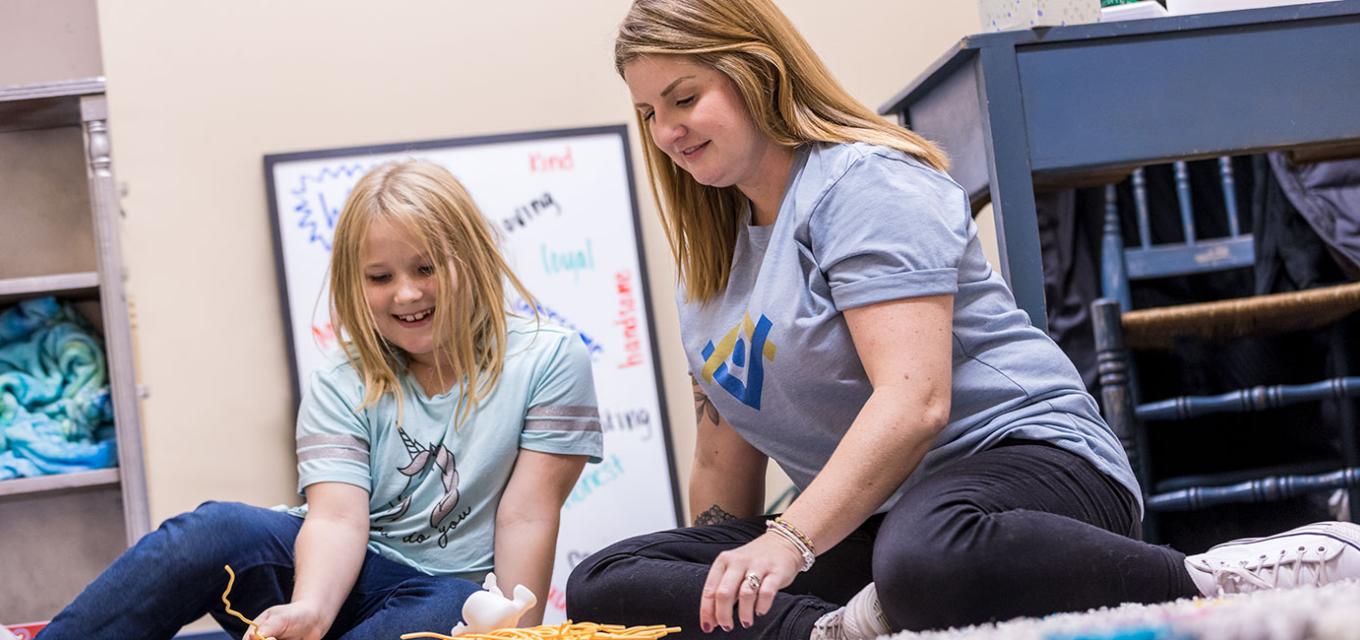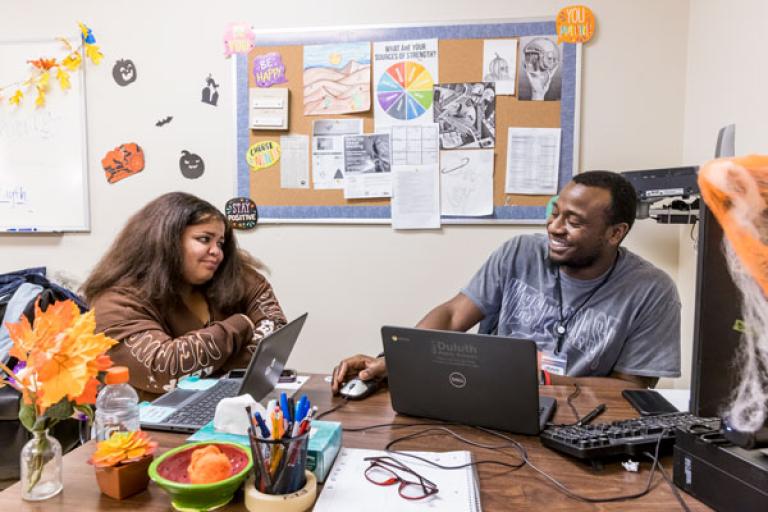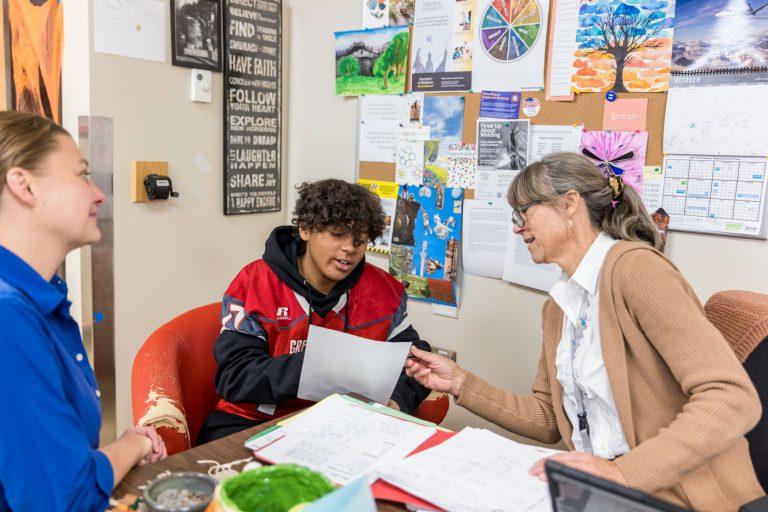2023 Winter

Scaling student engagement
A popular dropout prevention plan pivots.
Troubling declines in national test scores and high school graduation rates laid bare the pandemic’s devastating effects on students. Absenteeism and learning loss could hurt classroom performance for years to come, scholars fear. Enter Check & Connect, an evidence-based intervention created at CEHD’s Institute on Community Integration (ICI) decades ago that is leveraging a digital app to track students on a wider scale. It’s also adapting its model to boost attendance, performance, and graduation rates at more schools.
About 900 students are enrolled in Check & Connect across almost every K-12 school in St. Louis County in northern Minnesota this fall. County officials last year tapped American Rescue Plan Act funds to hire dedicated program mentors, matching them with at-risk students. Today, nearly 50 mentors are developing supportive relationships with students, in addition to electronically charting attendance, behavior, and grades.
“People said we’d never staff all these positions, but we were actually able to be selective, getting the right people for the positions,” says Sarah Laulunen, the Check & Connect coordinator for Duluth School District, which had begun implementing the program before the county adopted it on a larger scale. “These mentors are really web weavers who engage students, faculty, and staff.”

Photo credit: David J. Turner
A desktop app version of the model enables faster recordkeeping for such a large group of students and allows administrators to track progress and quickly troubleshoot areas of need. At the end of the 2021-22 school year, the county reported a 75 percent drop in school absences and a 62 percent decrease in suspensions from year-ago levels, says Jana Ferguson, ICI’s project coordinator overseeing implementation in the county.
After struggling last year, Destyni Clingerman, a junior at Duluth East High School, is getting better grades and planning for life after high school.
“Her grades didn’t reflect how good of a student she could be,” says her mentor, Shaq Coleman. “She’s doing a whole lot better now.”
At this, Clingerman smiles.
“He gets on my nerves, honestly,” she says, poking fun at her mentor’s high expectations. Asked what made this year a positive experience and what she would advise other students, she pointed inward.
“Be willing to try, and to think about the future,” she says. “Everyone says to just live in the present, but I want to graduate and move on. You have to try for yourself, versus doing it for others.”
Raleon “RJ” Moore’s love of football motivated him to turn around what could have been a poor start to high school.
“I want to go all the way to the NFL, to live my dream, and take care of my family,” said Moore, a freshman at Duluth East who joined Check & Connect last year as an eighth grader. After Moore fell behind in several classes, mentor Becky Davidson showed him a system for checking off tasks, with each success building to the next. As Moore entered high school this fall, mentor Bitsy Zwak worked with Davidson on the transition plan, and Moore is maintaining improved grades and attendance, along with his football eligibility.
“Teachers have been trying to support their students as best they can for many years, but today the issues are more serious,” says Zwak, a longtime paraprofessional at the school. “When kids see success and know they’ve driven it, their world explodes in this positive reaction.”
Moore says Davidson was enthusiastic and caring, but more importantly showed him a workable plan for getting back on track.
“She gave me hope in a system,” he says. “I know I have a lot to work on, but I don’t care about anything other than getting to where I need to be.”
Schools implement the program at all grade levels in hopes of heading off risks long before they become serious.
“Kids drop out not because something happens when they’re 17. It’s a cycle that begins very early,” says Lisa Perkovich, regional Check & Connect coordinator.
Once teachers identify students who would benefit from the program, most parents have been grateful, says mentor Nikki Kern.
“Last year, just getting her to want to come to school was a real battle,” says Ethan Stone, whose daughter Audrianna is a second grader at Parkview Elementary in Virginia, Minnesota. “Now she wakes up and is excited to go.”

Photo credit: David J. Turner
Meanwhile, a study at Central Lakes College to adapt the intervention for the postsecondary level shows students enrolled in Raider Connect earned higher average credit hours than a control group.
And Communities in Schools of Central Texas is one of several nonprofit organizations around the country that is deploying grant funding and other resources to implement the program. Early results have been positive, particularly among students engaged with the program for 16 or more hours, says Karen Gonzalez, innovation officer.
Check & Connect soon will be or has been implemented internationally, in after-school settings for students with disabilities transitioning from high school, with juvenile offenders, and embedded in refugee programs in the United States, in addition to traditional school settings in all 50 states. In the last five years, more than 500 trainers and coaches have learned how to teach coordinators and mentors how to implement the program, creating a pipeline to reach thousands of additional students, says Eileen Klemm, ICI’s national training director for Check & Connect.
Under a recent grant, ICI is releasing free online resources to help school personnel implement the program. The challenge for many schools now is finding financial support to keep mentors on the job, but the recent successes are promising.
“Many schools lost touch with families as the pandemic wore on, but those who had Check & Connect already in place had a mechanism for reaching out,” says Klemm. “Others started saying, ‘We need to re-engage students and this is a proven method, so let’s try it.’ When a leadership team understands the program and recruits the right champions, that’s when the magic happens.”
-JANET STEWART